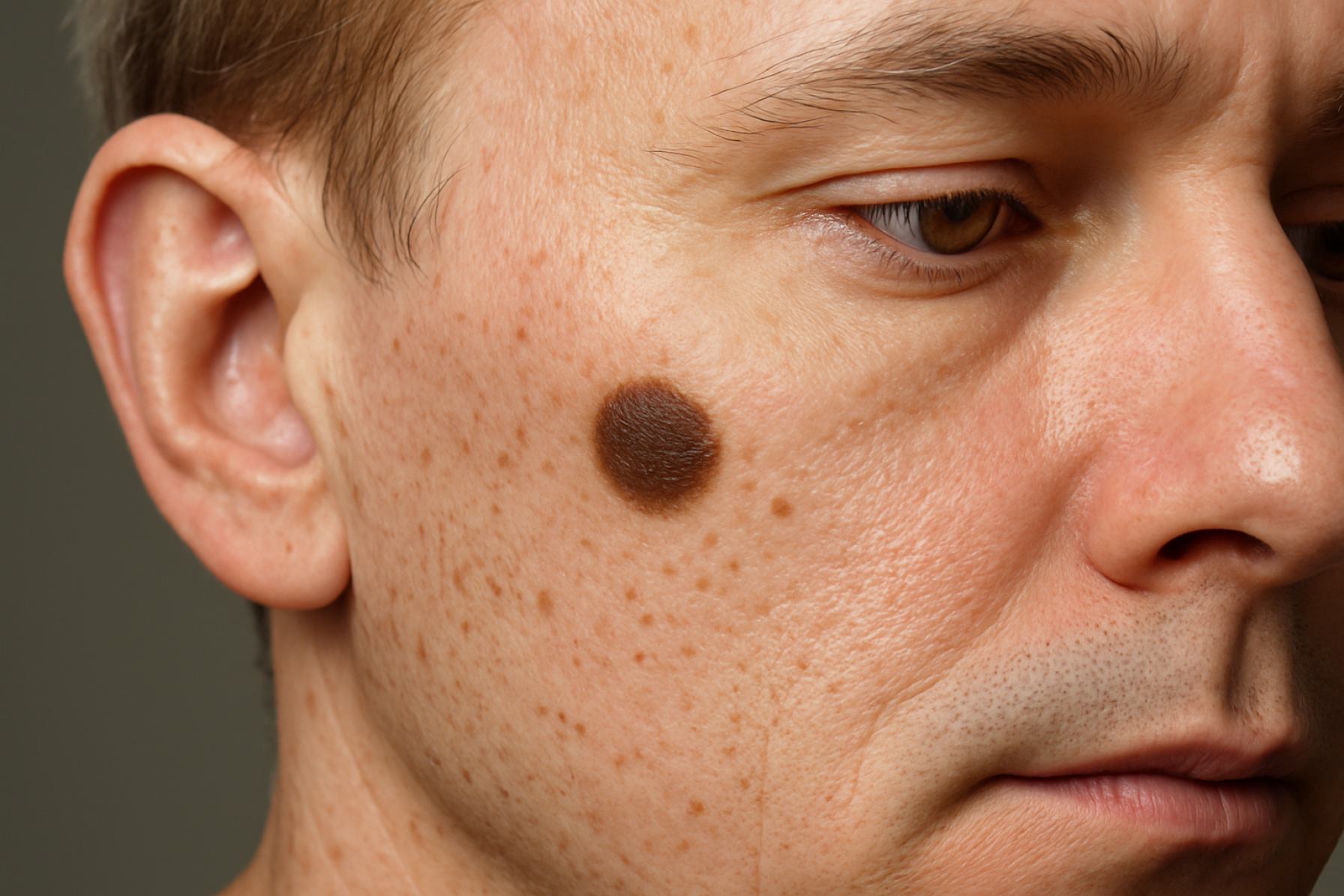Junctional Nevus Explained: What Every Dermatologist and Patient Should Know About This Common Yet Overlooked Skin Lesion. Discover the Latest Diagnostic Tools, Management Strategies, and Future Trends. (2025)
- Introduction to Junctional Nevus: Definition and Epidemiology
- Histopathological Features and Classification
- Clinical Presentation and Differential Diagnosis
- Genetic and Molecular Insights
- Current Diagnostic Techniques and Innovations
- Management Strategies: Observation vs. Excision
- Malignant Transformation Risk: Myths and Realities
- Patient Education and Counseling Best Practices
- Emerging Technologies and Future Directions
- Public Awareness, Research Trends, and Forecasted Interest (2024–2030)
- Sources & References
Introduction to Junctional Nevus: Definition and Epidemiology
A junctional nevus is a type of melanocytic nevus (commonly known as a mole) characterized by the proliferation of melanocytes—pigment-producing cells—at the junction of the epidermis and dermis layers of the skin. These lesions typically present as flat or slightly elevated, uniformly pigmented macules, most often brown to black in color. Junctional nevi are distinguished histologically by nests of melanocytes confined to the basal layer of the epidermis, without extension into the underlying dermis. This feature differentiates them from compound and intradermal nevi, which involve deeper skin layers.
Epidemiologically, junctional nevi are among the most common types of acquired melanocytic nevi, particularly prevalent in children and adolescents. The majority of these lesions appear during the first two decades of life, with their incidence peaking in adolescence and gradually declining in adulthood as many junctional nevi evolve into compound or intradermal nevi. The global prevalence of melanocytic nevi, including junctional types, varies by population, skin type, and geographic region, but studies suggest that most individuals develop at least a few nevi during their lifetime. The World Health Organization recognizes the importance of monitoring melanocytic nevi due to their potential—albeit low—for malignant transformation, particularly in the context of melanoma risk.
Recent data up to 2025 indicate that the incidence and clinical management of junctional nevi are influenced by increased public awareness of skin cancer and advances in dermatological screening. The widespread adoption of dermoscopy and digital monitoring tools has improved the early detection and differentiation of benign nevi from atypical or malignant lesions. Organizations such as the American Academy of Dermatology and the American Cancer Society continue to emphasize regular skin examinations and public education campaigns, which are expected to further impact the epidemiology of junctional nevi in the coming years.
Looking ahead, ongoing research into the genetic and environmental factors influencing nevus development is likely to refine risk stratification and management strategies. As of 2025, the outlook for individuals with junctional nevi remains favorable, with most lesions remaining benign throughout life. However, vigilance in monitoring changes in size, color, or shape is recommended, as these may signal atypia or malignant transformation. The integration of artificial intelligence in dermatological practice is anticipated to enhance diagnostic accuracy and epidemiological tracking of junctional nevi in the near future.
Histopathological Features and Classification
Junctional nevus is a type of melanocytic nevus characterized by the proliferation of melanocytes at the dermoepidermal junction. Histopathologically, these lesions are defined by nests or clusters of uniform melanocytes confined to the basal layer of the epidermis, without extension into the underlying dermis. The cells typically exhibit small, round to oval nuclei with inconspicuous nucleoli and scant cytoplasm, and mitotic figures are rare. The architectural pattern is generally symmetrical, and the lesion is sharply demarcated from the surrounding normal skin.
In 2025, the classification of melanocytic nevi, including junctional nevi, continues to be guided by the World Health Organization (WHO) and the International Agency for Research on Cancer (IARC), which emphasize a histopathological approach based on the location of nevus cells: junctional, compound, and intradermal. Junctional nevi are distinguished by the exclusive presence of nevus cells at the epidermal-dermal junction, in contrast to compound nevi (which have both junctional and dermal components) and intradermal nevi (where cells are found only in the dermis). This classification remains foundational for clinical management and risk assessment, as junctional nevi are more likely than intradermal nevi to undergo atypical changes, though the overall risk of malignant transformation remains low (World Health Organization).
Recent advances in digital pathology and artificial intelligence (AI) are influencing the histopathological evaluation of melanocytic lesions. In 2025, several academic centers and pathology laboratories are integrating AI-assisted image analysis to improve diagnostic accuracy and reproducibility in distinguishing benign junctional nevi from dysplastic nevi and early melanoma. These technologies are being validated in multi-center studies, with early results suggesting improved interobserver agreement and potential for earlier detection of atypical features (National Cancer Institute).
Immunohistochemical markers, such as Melan-A, HMB-45, and S-100, continue to play a supportive role in confirming the melanocytic origin of junctional nevi, especially in diagnostically challenging cases. Molecular techniques, including fluorescence in situ hybridization (FISH) and next-generation sequencing (NGS), are increasingly available in specialized centers for cases with ambiguous histology, although their routine use in typical junctional nevi remains limited due to cost and accessibility.
Looking ahead, the outlook for the classification and diagnosis of junctional nevi is expected to further benefit from ongoing research into digital pathology, molecular diagnostics, and consensus-driven histopathological criteria. These advances aim to enhance diagnostic precision, reduce unnecessary excisions, and ensure early identification of lesions with malignant potential, aligning with the broader goals of precision dermatopathology and patient-centered care.
Clinical Presentation and Differential Diagnosis
Junctional nevus is a type of melanocytic nevus characterized by the proliferation of melanocytes at the dermoepidermal junction. In 2025, the clinical presentation of junctional nevi remains a central focus in dermatology, particularly due to their potential for confusion with early melanoma and other pigmented lesions. Typically, junctional nevi present as flat or slightly elevated, uniformly pigmented macules or papules, most commonly appearing in childhood or adolescence. They are usually round or oval, with well-defined borders and coloration ranging from light to dark brown. Lesions are most frequently found on sun-exposed areas but can occur anywhere on the body.
Recent clinical guidelines emphasize the importance of distinguishing junctional nevi from other melanocytic lesions, such as compound nevi, intradermal nevi, and, most critically, early-stage melanoma. The American Academy of Dermatology (AAD) continues to recommend the use of the ABCDE criteria (Asymmetry, Border irregularity, Color variation, Diameter >6mm, and Evolution) as a first-line approach for evaluating pigmented lesions. However, junctional nevi typically lack the asymmetry and border irregularity seen in melanomas, and their color is usually uniform.
Dermoscopy has become an essential tool in the differential diagnosis of junctional nevi. In 2025, advances in digital dermoscopy and artificial intelligence (AI)-assisted image analysis are increasingly integrated into clinical practice, improving diagnostic accuracy and reducing unnecessary excisions. Junctional nevi under dermoscopy often display a regular reticular or globular pattern, which helps differentiate them from atypical nevi and melanoma. The World Health Organization (WHO) and the European Academy of Dermatology and Venereology (EADV) both highlight the role of non-invasive imaging in their current recommendations for the management of melanocytic lesions.
Despite these advances, the differential diagnosis remains challenging in certain cases, especially in lesions with atypical features or in patients with a personal or family history of melanoma. Histopathological examination remains the gold standard for definitive diagnosis when clinical and dermoscopic findings are inconclusive. The outlook for the next few years includes further refinement of AI-based diagnostic tools and the development of molecular assays to aid in distinguishing benign junctional nevi from early melanoma, as supported by ongoing research initiatives from organizations such as the National Cancer Institute (NCI).
In summary, the clinical presentation of junctional nevus in 2025 is well-characterized, but its differentiation from other pigmented lesions—especially melanoma—continues to drive innovation in diagnostic techniques. Ongoing collaboration among dermatological societies and research institutions is expected to further enhance diagnostic precision and patient outcomes in the coming years.
Genetic and Molecular Insights
Junctional nevus, a type of melanocytic nevus characterized by the proliferation of melanocytes at the dermoepidermal junction, has been the subject of increasing genetic and molecular research in recent years. As of 2025, advances in genomic sequencing and molecular pathology are providing new insights into the pathogenesis and clinical behavior of these lesions.
Recent studies have confirmed that junctional nevi frequently harbor mutations in genes associated with the mitogen-activated protein kinase (MAPK) pathway, particularly BRAF and NRAS. These mutations are similar to those found in other benign nevi and some melanomas, suggesting a shared early oncogenic event. However, the presence of additional genetic or epigenetic alterations appears necessary for malignant transformation, which remains rare in junctional nevi. Ongoing research is focused on identifying these secondary events and understanding their role in nevus progression.
In 2024 and 2025, the application of single-cell RNA sequencing and spatial transcriptomics has enabled researchers to dissect the cellular heterogeneity within junctional nevi. These technologies are revealing distinct subpopulations of melanocytes and their interactions with the local microenvironment, including immune cells and keratinocytes. Such findings are expected to refine diagnostic criteria and may lead to the identification of biomarkers for early detection of atypical transformation.
Epigenetic profiling, including DNA methylation and histone modification studies, is also gaining traction. Early results suggest that specific methylation patterns may distinguish benign junctional nevi from dysplastic nevi and early melanoma, offering potential for non-invasive diagnostic assays. The integration of these molecular signatures into clinical practice is anticipated within the next few years, pending validation in larger cohorts.
International organizations such as the World Health Organization (WHO) and the National Cancer Institute (NCI) continue to update classification systems and guidelines based on emerging molecular data. The WHO’s latest skin tumor classification incorporates genetic findings, underscoring the importance of molecular diagnostics in dermatopathology.
Looking ahead, the convergence of genomics, transcriptomics, and digital pathology is expected to transform the management of junctional nevi. Personalized risk assessment, improved diagnostic accuracy, and targeted surveillance strategies are likely outcomes as these molecular insights are translated into clinical protocols. Collaborative efforts between academic centers, regulatory agencies, and professional societies will be crucial in standardizing and implementing these advances globally.
Current Diagnostic Techniques and Innovations
Junctional nevus, a type of melanocytic nevus characterized by nests of melanocytes located at the dermoepidermal junction, remains a diagnostic challenge due to its clinical and histopathological overlap with early melanoma. As of 2025, the diagnostic landscape for junctional nevi is evolving, with a focus on improving accuracy, reducing unnecessary excisions, and integrating advanced technologies.
The gold standard for diagnosis continues to be histopathological examination following excisional or punch biopsy. However, non-invasive and minimally invasive diagnostic techniques are gaining traction. Dermoscopy, which enhances visualization of subsurface skin structures, is now widely adopted in dermatology clinics. Recent studies have shown that dermoscopy increases diagnostic sensitivity and specificity for melanocytic lesions, including junctional nevi, when compared to naked-eye examination. The use of digital dermoscopy and artificial intelligence (AI)-assisted image analysis is expanding, with several AI algorithms demonstrating performance comparable to expert dermatologists in distinguishing benign from malignant lesions. These tools are being validated in multi-center studies and are expected to see broader clinical integration in the next few years.
Reflectance confocal microscopy (RCM) is another non-invasive imaging modality that provides cellular-level resolution of the skin in vivo. RCM is particularly useful for ambiguous lesions, allowing for real-time assessment of architectural and cytological features. While RCM is currently available in specialized centers, ongoing efforts aim to improve its accessibility and cost-effectiveness, potentially making it a more routine adjunct in the diagnostic workflow for junctional nevi.
Molecular diagnostics are also emerging as a supplementary tool. Techniques such as fluorescence in situ hybridization (FISH) and comparative genomic hybridization (CGH) can help differentiate benign nevi from melanoma in histologically equivocal cases. Although not yet standard practice, these methods are being incorporated into diagnostic algorithms in academic and tertiary care settings, with ongoing research focused on refining their clinical utility and cost-benefit profile.
Professional organizations such as the American Academy of Dermatology and the World Health Organization continue to update guidelines and educational resources to reflect these technological advancements. Looking ahead, the integration of digital health records, teledermatology, and AI-driven decision support systems is anticipated to further enhance early and accurate diagnosis of junctional nevi, ultimately improving patient outcomes and optimizing resource utilization.
Management Strategies: Observation vs. Excision
Management of junctional nevus—a melanocytic lesion characterized by nests of melanocytes at the dermoepidermal junction—continues to evolve in 2025, with clinical decisions balancing the risks of malignant transformation against the morbidity of unnecessary excision. The two primary strategies remain careful observation and surgical excision, with the choice guided by lesion characteristics, patient risk factors, and emerging diagnostic technologies.
Current consensus among dermatological authorities, such as the American Academy of Dermatology and British Association of Dermatologists, is that most junctional nevi are benign and stable throughout life. Observation is generally recommended for lesions that are small, symmetric, uniformly pigmented, and show no clinical or dermoscopic signs of atypia. Regular follow-up with digital dermoscopy and photographic documentation is increasingly standard, allowing for early detection of morphological changes suggestive of dysplasia or malignant transformation.
Excision is reserved for junctional nevi exhibiting atypical features—such as asymmetry, border irregularity, color variegation, diameter over 6 mm, or evolving appearance—or for lesions located in anatomically high-risk areas (e.g., mucosal surfaces, palms, soles). The World Health Organization and national cancer guidelines continue to emphasize the importance of histopathological examination following excision, as this remains the gold standard for diagnosis and risk stratification.
Recent advances in non-invasive imaging, including reflectance confocal microscopy and AI-assisted dermoscopy, are influencing management strategies. These technologies, endorsed by organizations like the European Academy of Dermatology and Venereology, are improving diagnostic accuracy and reducing unnecessary excisions by better distinguishing benign from atypical lesions. Ongoing studies in 2025 are evaluating the long-term outcomes of observation versus excision, particularly in pediatric populations and individuals with genetic predispositions to melanoma.
Looking ahead, the outlook for management of junctional nevi is expected to further shift toward personalized, risk-adapted approaches. Integration of molecular diagnostics and digital monitoring tools is anticipated to refine risk assessment and minimize overtreatment. However, until these technologies are universally accessible and validated, the dichotomy between observation and excision will remain central to clinical practice, guided by established criteria and expert consensus from leading dermatological organizations.
Malignant Transformation Risk: Myths and Realities
Junctional nevus is a type of melanocytic nevus characterized by nests of melanocytes located at the dermoepidermal junction. Historically, there has been significant concern regarding the potential for malignant transformation of junctional nevi into melanoma. However, recent research and consensus among dermatological authorities in 2025 have clarified many misconceptions, providing a more nuanced understanding of the actual risks involved.
Current data indicate that the risk of malignant transformation of a typical junctional nevus in adults is exceedingly low. Large-scale cohort studies and meta-analyses published in the last few years have consistently shown that the vast majority of junctional nevi remain benign throughout a person’s lifetime. The American Academy of Dermatology (AAD), a leading authority in skin health, emphasizes that while all melanocytic nevi should be monitored for changes, routine excision of stable, asymptomatic junctional nevi is not recommended in the absence of suspicious features.
The main risk factors for malignant transformation remain atypical clinical or histopathological features, such as asymmetry, border irregularity, color variegation, diameter greater than 6 mm, and evolving characteristics—summarized by the ABCDE criteria. The American Cancer Society and the World Health Organization (WHO) both highlight that transformation is more likely in congenital nevi or those with significant dysplasia, rather than in common acquired junctional nevi.
Recent advances in dermoscopy and digital monitoring have further reduced unnecessary excisions by allowing dermatologists to distinguish benign from suspicious lesions with greater accuracy. Artificial intelligence (AI)-assisted diagnostic tools, increasingly adopted in dermatology clinics, are expected to further improve early detection of malignant changes while minimizing overtreatment of benign nevi over the next few years.
Despite persistent myths, there is no evidence that minor trauma, irritation, or routine skin care practices increase the risk of malignant transformation in junctional nevi. The Centers for Disease Control and Prevention (CDC) and the AAD both stress the importance of public education to dispel such misconceptions, focusing instead on regular self-examination and professional skin checks for high-risk individuals.
Looking ahead, ongoing research into the molecular genetics of melanocytic nevi may yield more precise risk stratification tools, but as of 2025, the consensus remains that the malignant potential of typical junctional nevi is minimal. Continued vigilance, patient education, and evidence-based monitoring protocols are expected to remain the standard of care in the foreseeable future.
Patient Education and Counseling Best Practices
Patient education and counseling are critical components in the management of junctional nevus, a type of melanocytic nevus characterized by nests of melanocytes located at the dermoepidermal junction. As of 2025, best practices emphasize a patient-centered approach, integrating the latest evidence-based guidelines and leveraging digital health tools to enhance understanding and engagement.
Current recommendations from leading dermatological organizations, such as the American Academy of Dermatology and the World Health Organization, stress the importance of clear communication regarding the benign nature of most junctional nevi, while also educating patients about the rare but possible risk of malignant transformation. Counseling should include visual aids and digital dermatoscopic images to help patients recognize typical features—such as flat, uniformly pigmented macules—and distinguish them from atypical lesions that may warrant further evaluation.
In 2025, digital platforms and teledermatology are increasingly utilized for patient education, allowing for remote monitoring and follow-up. These tools support ongoing patient engagement, especially for individuals in underserved or rural areas. The Centers for Disease Control and Prevention highlights the role of telehealth in improving access to dermatological care and patient education, particularly in the context of skin cancer prevention and early detection.
Best practices also include providing patients with up-to-date, evidence-based educational materials, both in print and online formats. Materials should be culturally sensitive and available in multiple languages to address diverse patient populations. The National Cancer Institute recommends using plain language and visual guides to explain when to seek medical attention for changes in a nevus, such as asymmetry, border irregularity, color variation, diameter enlargement, or evolving characteristics (the ABCDEs of melanoma).
Looking ahead, the integration of artificial intelligence (AI) in patient education is expected to expand. AI-driven apps and decision-support tools can provide personalized risk assessments and reminders for self-examination, further empowering patients. However, these technologies are being developed with oversight from regulatory bodies such as the U.S. Food and Drug Administration to ensure accuracy and safety.
In summary, patient education and counseling for junctional nevus in 2025 and beyond are increasingly interactive, technology-enabled, and tailored to individual needs. Ongoing collaboration between healthcare providers, patients, and authoritative organizations will continue to shape best practices, with the goal of improving outcomes through informed self-care and timely medical intervention.
Emerging Technologies and Future Directions
Emerging technologies are poised to significantly impact the diagnosis, management, and understanding of junctional nevus in 2025 and the coming years. Junctional nevi, which are melanocytic lesions located at the dermoepidermal junction, present a diagnostic challenge due to their potential for atypical features and, rarely, malignant transformation. Recent advances in digital pathology, artificial intelligence (AI), and molecular diagnostics are reshaping the clinical landscape.
One of the most promising developments is the integration of AI-driven image analysis into dermatology. Deep learning algorithms, trained on large datasets of dermoscopic images, are now capable of distinguishing between benign and atypical nevi with accuracy approaching that of expert dermatopathologists. In 2025, several academic centers and technology companies are collaborating to refine these tools, aiming for regulatory approval and broader clinical adoption. The U.S. Food and Drug Administration has begun evaluating AI-based diagnostic platforms for skin lesion assessment, with pilot programs underway to validate their safety and efficacy.
Molecular diagnostics are also advancing rapidly. Next-generation sequencing (NGS) and gene expression profiling are being explored to differentiate benign junctional nevi from early melanoma at the molecular level. These techniques can identify mutations and expression patterns characteristic of malignancy, offering a potential adjunct to traditional histopathology. The National Cancer Institute is supporting research into molecular biomarkers that could be incorporated into routine diagnostic workflows within the next few years.
Non-invasive imaging technologies, such as reflectance confocal microscopy (RCM) and optical coherence tomography (OCT), are gaining traction for real-time, in vivo evaluation of pigmented lesions. These modalities provide cellular-level resolution without the need for biopsy, reducing patient discomfort and enabling longitudinal monitoring. The American Academy of Dermatology is actively promoting education and research on these technologies, anticipating their increased use in community and academic settings.
Looking ahead, the convergence of digital, molecular, and imaging innovations is expected to enhance early detection and risk stratification of junctional nevi. This will likely lead to more personalized management strategies, minimizing unnecessary excisions while ensuring prompt intervention for lesions with malignant potential. Ongoing collaboration between regulatory agencies, research institutions, and industry stakeholders will be critical to translating these advances into standard clinical practice over the next several years.
Public Awareness, Research Trends, and Forecasted Interest (2024–2030)
Public awareness and research interest in junctional nevus—a type of melanocytic nevus characterized by nests of melanocytes located at the dermoepidermal junction—are expected to evolve significantly between 2024 and 2030. This evolution is driven by increasing skin cancer prevention campaigns, advances in dermatological diagnostics, and a growing emphasis on early melanoma detection.
In 2025, public health organizations and dermatology societies are intensifying educational efforts to distinguish benign lesions like junctional nevi from atypical or malignant melanocytic proliferations. The American Academy of Dermatology (AAD), a leading authority in skin health, continues to promote skin self-examination and awareness of changes in moles, including junctional nevi, as part of its annual Skin Cancer Awareness Month and year-round outreach. These campaigns are increasingly leveraging digital platforms and teledermatology, making information more accessible to the public and primary care providers.
On the research front, 2025 is witnessing a surge in studies focused on the molecular and genetic underpinnings of junctional nevi. Academic centers and collaborative consortia, such as those coordinated by the National Institutes of Health (NIH), are prioritizing research that clarifies the risk factors for nevus transformation and the genetic markers that may predict progression to melanoma. The integration of artificial intelligence (AI) in dermoscopic analysis is also a prominent trend, with several research groups developing and validating algorithms to improve the accuracy of distinguishing junctional nevi from dysplastic nevi and early melanomas.
Forecasts for the next five years suggest that public interest in junctional nevi will continue to rise, paralleling broader concerns about skin cancer and sun safety. The World Health Organization (WHO) and national cancer registries are expected to release updated epidemiological data, further informing public health strategies and resource allocation. Additionally, the proliferation of mobile health applications and wearable skin sensors is anticipated to empower individuals to monitor their skin health more proactively, potentially leading to earlier detection and intervention.
In summary, the period from 2024 to 2030 is likely to see sustained growth in both public awareness and scientific inquiry related to junctional nevi. This trend is underpinned by technological innovation, robust public health initiatives, and a global commitment to reducing the burden of skin cancer through education and research.
Sources & References
- World Health Organization
- American Academy of Dermatology
- American Cancer Society
- National Cancer Institute
- European Academy of Dermatology and Venereology
- American Academy of Dermatology
- World Health Organization
- British Association of Dermatologists
- Centers for Disease Control and Prevention
- National Institutes of Health
 North Las Vegas & Enterprise Real Estate: Market Expansion, Trends, and Long-Term Projections
North Las Vegas & Enterprise Real Estate: Market Expansion, Trends, and Long-Term Projections  Blue Origin’s Bold Comeback: “Never Tell Me The Odds” Booster to Challenge SpaceX With August Launch
Blue Origin’s Bold Comeback: “Never Tell Me The Odds” Booster to Challenge SpaceX With August Launch  Billion-Euro Bet: UK Supercharges Global Race for Limitless Fusion Energy with Marvel Fusion Deal
Billion-Euro Bet: UK Supercharges Global Race for Limitless Fusion Energy with Marvel Fusion Deal  Dell’s Bold Move: New India Head, Surging AI Partnerships, and a Stock Price Rocketing 24%—What’s Next for This Tech Giant?
Dell’s Bold Move: New India Head, Surging AI Partnerships, and a Stock Price Rocketing 24%—What’s Next for This Tech Giant?  Lucid Group’s Bold Boardroom Shakeup: Is a Turnaround Finally Coming for This EV Underdog?
Lucid Group’s Bold Boardroom Shakeup: Is a Turnaround Finally Coming for This EV Underdog?  JWST’s Largest Cosmic Map Ever Stuns Astronomers: See Nearly 800,000 Ancient Galaxies in Unprecedented Detail
JWST’s Largest Cosmic Map Ever Stuns Astronomers: See Nearly 800,000 Ancient Galaxies in Unprecedented Detail  Russia’s Air Power Shaken: Shocking Satellite Images Reveal Scale of Ukraine’s Latest Drone Strike
Russia’s Air Power Shaken: Shocking Satellite Images Reveal Scale of Ukraine’s Latest Drone Strike  XRP Skyrockets: Wall Street and Asia Rush to Make Ripple Token the Next Big Treasury Asset
XRP Skyrockets: Wall Street and Asia Rush to Make Ripple Token the Next Big Treasury Asset  Spatial Transcriptomics Analysis Platforms Market 2025: Rapid AI Integration Drives 18% CAGR Through 2030
Spatial Transcriptomics Analysis Platforms Market 2025: Rapid AI Integration Drives 18% CAGR Through 2030 